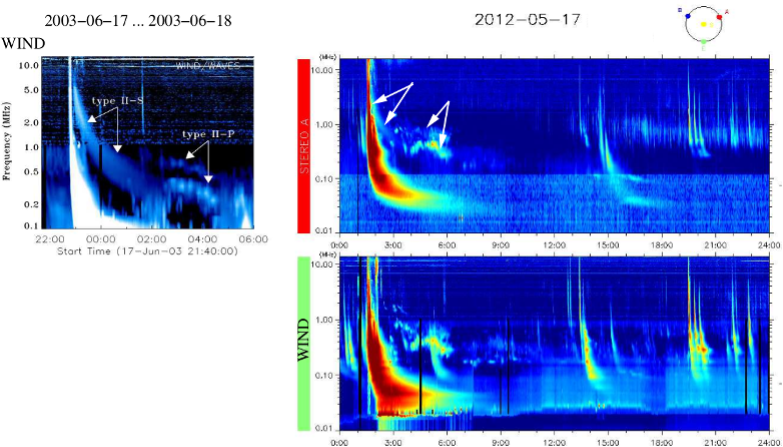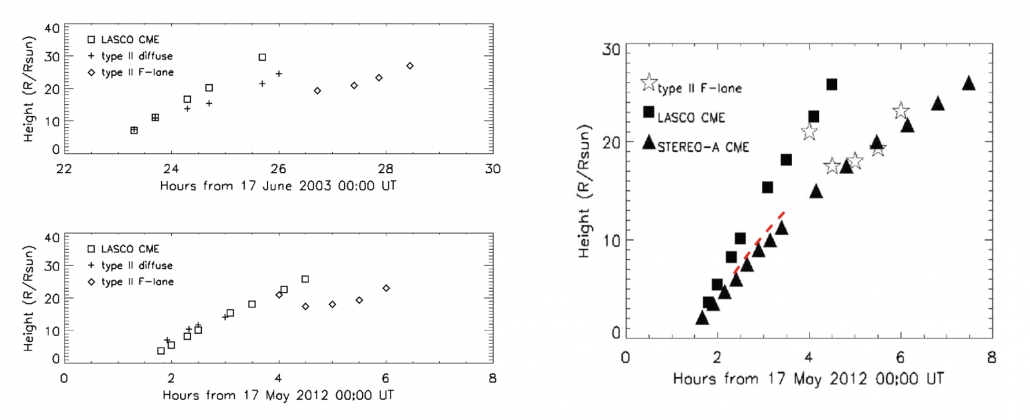A distinct class of interplanetary (IP) type II bursts that show single-lane, wide-band diffuse emission has been identified, but how these bursts are formed is still unclear. The radio burst on June 17-18, 2003 was analysed by Bastian (2007) , who suggested that the wide-band and diffuse part of the burst (type II-S in Fig. 1) could be due to synchrotron emission. The later part of the burst (type II-P) could be identified as plasma emission because of the fundamental-harmonic (F-H) lane pair. A similar-looking two-part burst has been discovered to have occurred on May 17, 2012. In this later event, there are radio data available from three different spacecraft, STEREO-A, STEREO-B, and Wind. The wide-band diffuse emission was visible only in the STEREO-A dynamic spectrum, i.e., only from one viewing angle. This study investigates the conditions where two-part type II bursts are formed, to find out possible explanations for the untypical radio emission structures.

Figure 1. Left: The June 17-18, 2003 type II burst event that included a possible synchrotron-emitting source (type II-S) and a plasma emission source (type II-P), the figure was published by Bastian (2007). Right: The May 17, 2012 type II burst event that showed a similar two-part structure in the radio emission.
Observations
The 2003 and 2012 events were both associated with high-speed, halo-type CMEs. In the 2003 event a M6.8 GOES class flare was located at S07E55, but no EUV wave was observed. In the 2012 event a M5.1 GOES class flare was located near N11E42 in the STEREO-A view (at N11W76 in Earth view), and an EUV wave was observed. For the 2012 event, Shen et al. (2013) suggested that there could be two eruptions (CMEs) present, and later Grechnev et al. (2024) concluded that there could be two wave-like disturbances and a later halo-shock involved, suggesting that there could be three separate type II bursts as well.
In the present study, the height-time evolution of the diffuse and F-lane type II emission, compared with the LASCO CME height evolution, look similar in both events (Fig. 2, left panel). However, in the 2012 event the STEREO-A CME heights are much lower than the LASCO CME heights (Fig. 2, right panel). The type II-P emission heights (F-lane, marked with stars) are close to the STEREO-A CME heights most of the time.

Figure 2. Left: Height-time plots for the two events, showing SOHO/LASCO CME heights with the radio source heights for the two-part type II bursts. Right: CME heights from SOHO/LASCO and STEREO-A for the 2012 event, with radio source heights of the type II-P (F-lane) emission. Red dashed line indicates the heights of a white-light shock region near the CME leading front.
Questions
Comparison of the diffuse type II emission heights and the LASCO CME heights suggest that the radio emission originates from a CME bow shock, although in the 2003 event there is a growing height difference. So, could the diffuse radio emission in some cases be due to synchrotron radiation?
In these two events, the diffuse type II burst weakens and disappears from the spectrum near the time when the F-H type II burst becomes visible. Pohjolainen, Allawi, and Valtonen (2013) found that in most diffuse type II bursts the emission lasts longer and it can be followed to much lower frequencies. So, is the ending of the diffuse burst a precondition for the formation and appearance of the F-H burst? Are two-part type II shocks created by one single CME, or are they created by more than one CME and several shocks, as the 2012 event suggests?
The radio emission in the 2012 event was observed from three different viewing angles, but only one of them showed the diffuse emission. Are there directivity effects in the diffuse emission, like in type IV bursts? Type IV bursts are complex and can contain multiple emission mechanisms, as synchrotron-emitting electrons get trapped within a moving magnetic cloud (Mohan et al., 2024) .
Conclusions
Several explanations exist for the creation of these radio bursts. But, without imaging at DH wavelengths the true radio source locations are not known. Homologous events present a challenge to theory and simulations, as how to produce similar emission features.
Based on the recent paper by Silja Pohjolainen, Two-Part Interplanetary Type II Solar Radio Bursts, Sol. Phys. 300, id.25, 2025, DOI:10.1007/s11207-025-02449-5
References
Bastian, T. S.: 2007, ApJ 665, 805
Grechnev, V.V., Kiselev, V.I., Uralov, A.M., et al.: 2024, Sol. Phys., 299, id.129
Mohan, A., Gopalswamy, N., Kumari, A., et al.: 2024, ApJ, 971, id.86
Pohjolainen, S., Allawi, H., Valtonen, E.: 2013, A&A, 558, id.A7
Shen, C., Li, G., Kong, X., et al.: 2013, ApJ, 763, id.114
